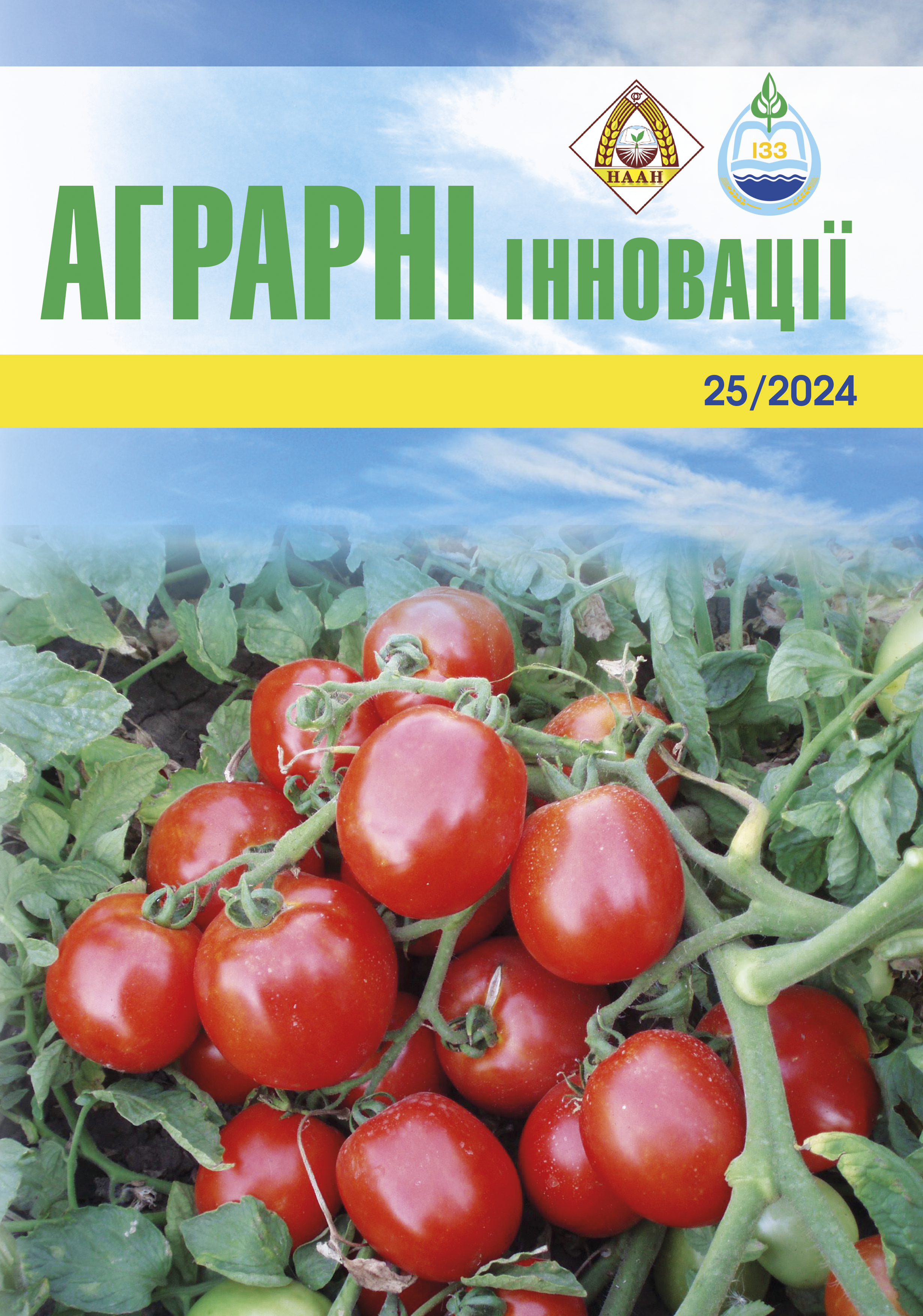Contamination of winter barley grain by fungal pathogens in the Steppe of Ukraine
Abstract
The purpose – to determine the mycoflora composition of winter barley seeds in the conditions of the Steppe of Ukraine. Research methods and materials. Barley grain samples of the 2021–2022 winter harvest were collected at the farm of the «Elita» JSC of the Izmail district of the Odesa region. The methodological basis of this research is: empirical (field selections; measurement of indicators of the research object), theoretical (proposing a hypothesis and forming conclusions based on research results); statistical;mathematical. The results. It was found that the infection rate in 2021 was higher (75.4%) compared to 2022 (30.5%). This is primarily due to weather conditions that adversely affected plants during the 2021 growing season. It was established that in all samples of winter barley varieties of 2021, fungi of the genus Fusarium spp. from 10.0% to a maximum of 15.0%. Pathogens Helminthosporium spp. the grain of the Ninth Val variety was most affected (25.0%). The dominant species during the growing season in the pathogenic complex were fungi of the genus Alternaria spp, they affected from 55.0% to 70.0% of winter barley seeds, the Snow Queen and Valkyrie varieties were most prominent. It was established that 3.0 to 7.0% of winter barley grains were affected by Cladosporium herbarum fungi. It was investigated that in the conditions of2022, Helminthosporium spp. dominated among grains infected with pathogens. from 45.0% to 50.0%. The detection frequency of Cladosporium herbarum was higher this year and ranged from 5.0% to 14.0%. We investigated that the grain was colonized by species of fungi of the genus Fusarium spp. from 5.0% to 8.0%. A significant percentage of grain was affected by Alternaria spp., the analyzed indicators ranged from 30.0% to 40.0%. A specific proportion of Penicillium spp. was at a low level and amounted to (1.0%–2.0%). Conclusions. In the years 2021–2022, the level of infection of grain of winter barley varieties with pathogenic fungi was high in the «Elita» SC of the Izmail district of the Odesa region. Infection by pathogens in the Steppe zone of Ukraine to a large extent also depended on the amount of precipitation in the flowering phase – milk ripeness. It was they who contributed to the initial signs of the disease and created conditions for the gradual accumulation of infectious potential on winter barley crops.
References
України. Селекція і насінництво. 2013. Вип. 103. С. 231–240.
2. Рудник-Іващенко О. І. Особливості вирощування озимих культур за умов змін клімату. Сортовивчення та охорона прав на сорти рослин. 2012. № 2. С. 8–10.
3. Бабан Т. О. Динаміка світового виробництва ячменю та роль України у формуванні його пропозиції. Наукові праці ПДАА. 2012. Т. 1. Вип. 2 (5). С. 18–21.
4. Корхова М. М., Іщук О. Стан та перспективи виробництва насіння ячменю озимого в Миколаївській області. Стан і перспективи впровадження ресур-
соощадних, енергозберігаючих технологій вирощування сільськогосподарських культур : матеріали ІІ
міжн. наук. практ. конф., (м. Дніпр, 15-16 листопада2017 р.). Дніпро, 2017. С. 141–142.
5. Гудзенко В. М., Васильківський С. П. Основні напрями та завдання селекції ячменю озимого у
Центральному Лісостепу України. Новітні агро-технології. 2016. № 1. URL: http://plant.gov.ua/sites/default/files/articles/2_-_gudzenko_vasylkivskyi.pdf.
6. Нагірний В. В. Вплив сроків сівби та мікродобрив на продуктивність сортів ячменю озимого в умвах Півдня України: автореф. дис…к-та с.-г. наук :
06.01.09 «Рослинництво». Херсон, 2020. 20 с.
7. Hudzenko V. M., Polishchuk T. P., Lysenko A. A., Fedorenko I. V., Fedorenko M. V., Khudolii L. V., Ishchenko V. A.,
Kozelets H. M., Babenko A. I., Tanchyk S. P. Elucidation of gene action and combining ability for productive
tillering in spring barley. Regulatory Mechanisms in Biosystems. 2022. V. 13, Iss. 2. P. 197–206. https://doi.org/10.15421/022225.
8. Рекомендації з догляду за озимими колосовими та сівба ярих зернових в господарствах Львівської
області під урожай 2021 року. Львів – Оброшине, 2021. 72 с.
9. Музафарова В. А., Рябчун В. К., Петухова І. А., Падалка О. І. Генетична колекція ячменю ярого за стійкістю до хвороб. Селекція і насінництво. 2016. Вип.
110. С. 107–116. doi: 10.30835/2413- 7510/2016/87617.
10. Bilovus G. Ya. Іnfluence of meteorological conditions and varietal peculiarities on development of fungal
diseases winter wheat. Збалансоване природокористування. 2016. V. 4. Is. 1. С. 76–80.
11. Hovhannisyan N. A., Dulloo M. E., Yesayan A. H. et al. Tracking of powdery mildew and leaf rust resistance genes in Triticum boeoticum and T. urartu, wild relatives
of common wheat. Czech J. Genet. Plant Breed. 2011. V. 47. Is. 2. P. 45–57. doi: 10.17221/127/2010-CJGPB.
12. Chen Z.-W., Lu R.-J., Zou L. et al. Genetic diversity analysis of barley landraces and cultivars in the Shanghai region of China. Genetics and Molecular
Research. 2012. V. 11. Р. 644 – 650. doi: 10.4238/2012. March.16.2.






